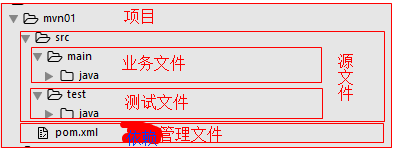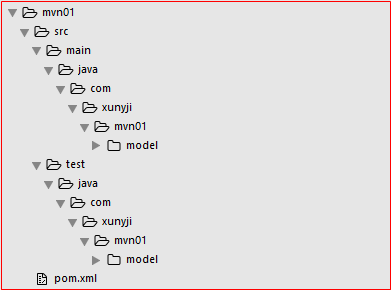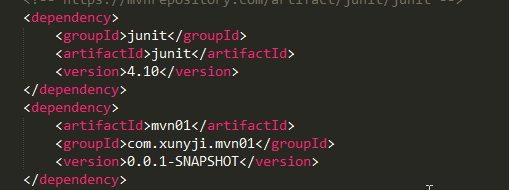Maven01 环境准备、maven项目结构、编译/测试/打包/清除、安装、
0 前提准备
0.1 安装java开发环境

0.2 安装maven工具

1 maven项目基本结构
如图所示,整个maven项目有业务文件、测试文件、POM依赖管理文件;其实还有一个资源文件resources;
代码文件和测试文件都是放在src文件中,src文件成为源文件;业务文件和测试文件处于src中同一级目录;
资源文件管理文件分为测试资源文件和业务资源文件,分别位于main目录和test目录,此处没有进行创建。

2 maven项目搭建
2.1 创建maven项目结构
安装maven规范的目录结构进行创建,创建结果如图所示

2.2 创建一个类
该类中只有一个返回类型为String类型的方法
package com.xunyji.mvn01.model;
public class HelloWorld {
public String sayHello() {
return "HelloWorld";
}
}
2.3 创建一个测试类并引入pom.xml文件
该测试类中引用了 HelloWorld 类,而且在该类中使用了Junit 提供的注解@Test
package com.xunyji.mvn01.model; import org.junit.*;
import org.junit.Assert.*;
import com.xunyji.mvn01.model.HelloWorld; public class HelloWorldTest { @Test
public void testHello() {
Assert.assertEquals("HelloWorld", new HelloWorld().sayHello());
} }
<?xml version="1.0" encoding="UTF-8"?>
<project xmlns="http://maven.apache.org/POM/4.0.0"
xmlns:xsi="http://www.w3.org/2001/XMLSchema-instance"
xsi:schemaLocation="http://maven.apache.org/POM/4.0.0 http://maven.apache.org/xsd/maven-4.0.0.xsd"> <modelVersion>4.0.</modelVersion> <artifactId>mvn01</artifactId>
<groupId>com.xunyji.mvn01</groupId>
<version>0.0.-SNAPSHOT</version> <dependencies>
<!-- https://mvnrepository.com/artifact/junit/junit -->
<dependency>
<groupId>junit</groupId>
<artifactId>junit</artifactId>
<version>4.10</version>
</dependency>
</dependencies> <!-- <build>
<plugins>
<plugin>
<groupId>org.springframework.boot</groupId>
<artifactId>spring-boot-maven-plugin</artifactId>
<configuration>
<mainClass>com.example.demo.DemoApplication</mainClass>
</configuration>
</plugin>
</plugins>
</build> --> </project>
pom.xml
2.4 编译、测试、打包、清除
利用maven进行首次编译和打包时会下载一些依赖
2.4.1 编译
mvn compile
技巧01:进入到项目根目录执行 mvn compile
技巧02:编译成功后会在项目根目录中创建一个target目录,并且将编译生成的业务代码对应的一些class文件(就是main中的java文件)放到target目录中
技巧03:mvn compile 命令只会对main里面的java文件进行编译,然后将生成的class文件放到target目录中

2.4.2 测试
mvn test
技巧01:进入到项目根目录执行 mvn test
技巧02:mvn test 命令会自动进行编译操作,而且是将main和test中的文件都进行编译,并将生成的class文件分类放到target目录中去

2.4.3 打包
mvn package
技巧01:进入到项目根目录执行 mvn package
技巧02:mvn package 会自动进行 mvn test 操作(即:打包前会对main和test中的文件进行编译并且对test中的文件进行测试)
技巧03:打包操作文成后会在target目录生成一个jar包(该jar包就是整个项目被打包后的结果)

2.4.4 清除
mvn clean
技巧01:进入到项目根目录执行 mvn clean
技巧02:清除操作就是删掉项目根目录下的target目录
3 安装
3.1 需求
现有两个java项目分别为mvn01、mvn02,mvn02需要用到mvn01项目中类
3.2 解决办法
3.2.1 IDEA解决
利用IDEA打开项目mvn02,并将mvn01对应的jar包导入到mvn01项目中
技巧01:mvn01对应的jar包需要导入到classpath路径中(参考博文)
3.2.2 maven解决
将mvn01对应的jar包放到本地仓库中,在mvn02中的pom.xml文件中导入mvn01对应的依赖即可
技巧01:进入到mvn01项目的根目录执行 mvn install 就可以将mvn01项目对应的jar包放到本地仓库去
3.3 实战
3.3.1 创建mvn02项目
》项目结构需要满足maven规范

》在main中创建一个Speak类
package com.xunyji.mvn02.util;
import com.xunyji.mvn01.model.HelloWorld;
public class Speak {
public String sayHay() {
return new HelloWorld().sayHello();
}
}
》在test中创建一个SpeakTest类
package com.xunyji.mvn02.util; import com.xunyji.mvn02.util.Speak;
import org.junit.*;
import org.junit.Assert.*; public class SpeakTest {
@Test
public void sayHayTest() {
Assert.assertEquals("HelloWorld", new Speak().sayHay());
}
}
》在pom中引入junit依赖和mvn01依赖

3.3.2 依赖说明
mvn02中使用了mvn01中的类后,在编译时就会先到项目的classpath路径中去寻找用到类是否存在;
可以直接将mvn01项目对应的jar包放到项目的classpath目录中,也可以通过该maven指定mvn01项目的依赖信息;
如果是利用maven引入mvn01项目依赖时,在编译时就会先到本地仓库去查找如果没有就回到远程仓库去查找,如果都没找到就会报错。
3.3.3 安装jar包到本地仓库
进入到mvn01项目的根目录执行 mvn install 就可以将mvn01项目对应的jar包安装到本地仓库中
技巧01:mvn安装目录下的conf目录下的settings.xml中可以修改本地仓库和远程仓库
<?xml version="1.0" encoding="UTF-8"?> <!--
Licensed to the Apache Software Foundation (ASF) under one
or more contributor license agreements. See the NOTICE file
distributed with this work for additional information
regarding copyright ownership. The ASF licenses this file
to you under the Apache License, Version 2.0 (the
"License"); you may not use this file except in compliance
with the License. You may obtain a copy of the License at http://www.apache.org/licenses/LICENSE-2.0 Unless required by applicable law or agreed to in writing,
software distributed under the License is distributed on an
"AS IS" BASIS, WITHOUT WARRANTIES OR CONDITIONS OF ANY
KIND, either express or implied. See the License for the
specific language governing permissions and limitations
under the License.
--> <!--
| This is the configuration file for Maven. It can be specified at two levels:
|
| . User Level. This settings.xml file provides configuration for a single user,
| and is normally provided in ${user.home}/.m2/settings.xml.
|
| NOTE: This location can be overridden with the CLI option:
|
| -s /path/to/user/settings.xml
|
| . Global Level. This settings.xml file provides configuration for all Maven
| users on a machine (assuming they're all using the same Maven
| installation). It's normally provided in
| ${maven.home}/conf/settings.xml.
|
| NOTE: This location can be overridden with the CLI option:
|
| -gs /path/to/global/settings.xml
|
| The sections in this sample file are intended to give you a running start at
| getting the most out of your Maven installation. Where appropriate, the default
| values (values used when the setting is not specified) are provided.
|
|-->
<settings xmlns="http://maven.apache.org/SETTINGS/1.0.0"
xmlns:xsi="http://www.w3.org/2001/XMLSchema-instance"
xsi:schemaLocation="http://maven.apache.org/SETTINGS/1.0.0 http://maven.apache.org/xsd/settings-1.0.0.xsd">
<!-- localRepository
| The path to the local repository maven will use to store artifacts.
|
| Default: ${user.home}/.m2/repository
<localRepository>/path/to/local/repo</localRepository>
-->
<localRepository>D://PTool/maven/apache-maven-3.5.0/conf/bdck</localRepository> <!-- interactiveMode
| This will determine whether maven prompts you when it needs input. If set to false,
| maven will use a sensible default value, perhaps based on some other setting, for
| the parameter in question.
|
| Default: true
<interactiveMode>true</interactiveMode>
--> <!-- offline
| Determines whether maven should attempt to connect to the network when executing a build.
| This will have an effect on artifact downloads, artifact deployment, and others.
|
| Default: false
<offline>false</offline>
--> <!-- pluginGroups
| This is a list of additional group identifiers that will be searched when resolving plugins by their prefix, i.e.
| when invoking a command line like "mvn prefix:goal". Maven will automatically add the group identifiers
| "org.apache.maven.plugins" and "org.codehaus.mojo" if these are not already contained in the list.
|-->
<pluginGroups>
<!-- pluginGroup
| Specifies a further group identifier to use for plugin lookup.
<pluginGroup>com.your.plugins</pluginGroup>
-->
</pluginGroups> <!-- proxies
| This is a list of proxies which can be used on this machine to connect to the network.
| Unless otherwise specified (by system property or command-line switch), the first proxy
| specification in this list marked as active will be used.
|-->
<proxies>
<!-- proxy
| Specification for one proxy, to be used in connecting to the network.
|
<proxy>
<id>optional</id>
<active>true</active>
<protocol>http</protocol>
<username>proxyuser</username>
<password>proxypass</password>
<host>proxy.host.net</host>
<port></port>
<nonProxyHosts>local.net|some.host.com</nonProxyHosts>
</proxy>
-->
</proxies> <!-- servers
| This is a list of authentication profiles, keyed by the server-id used within the system.
| Authentication profiles can be used whenever maven must make a connection to a remote server.
|-->
<servers>
<!-- server
| Specifies the authentication information to use when connecting to a particular server, identified by
| a unique name within the system (referred to by the 'id' attribute below).
|
| NOTE: You should either specify username/password OR privateKey/passphrase, since these pairings are
| used together.
|
<server>
<id>deploymentRepo</id>
<username>repouser</username>
<password>repopwd</password>
</server>
--> <!-- Another sample, using keys to authenticate.
<server>
<id>siteServer</id>
<privateKey>/path/to/private/key</privateKey>
<passphrase>optional; leave empty if not used.</passphrase>
</server>
-->
</servers> <!-- mirrors
| This is a list of mirrors to be used in downloading artifacts from remote repositories.
|
| It works like this: a POM may declare a repository to use in resolving certain artifacts.
| However, this repository may have problems with heavy traffic at times, so people have mirrored
| it to several places.
|
| That repository definition will have a unique id, so we can create a mirror reference for that
| repository, to be used as an alternate download site. The mirror site will be the preferred
| server for that repository.
|-->
<mirrors>
<!-- mirror
| Specifies a repository mirror site to use instead of a given repository. The repository that
| this mirror serves has an ID that matches the mirrorOf element of this mirror. IDs are used
| for inheritance and direct lookup purposes, and must be unique across the set of mirrors.
|
<mirror>
<id>mirrorId</id>
<mirrorOf>repositoryId</mirrorOf>
<name>Human Readable Name for this Mirror.</name>
<url>http://my.repository.com/repo/path</url>
</mirror>
-->
<mirror>
<id>aliyun</id>
<name>aliyun Maven</name>
<mirrorOf>*</mirrorOf>
<url>http://maven.aliyun.com/nexus/content/groups/public/</url>
</mirror>
</mirrors> <!-- profiles
| This is a list of profiles which can be activated in a variety of ways, and which can modify
| the build process. Profiles provided in the settings.xml are intended to provide local machine-
| specific paths and repository locations which allow the build to work in the local environment.
|
| For example, if you have an integration testing plugin - like cactus - that needs to know where
| your Tomcat instance is installed, you can provide a variable here such that the variable is
| dereferenced during the build process to configure the cactus plugin.
|
| As noted above, profiles can be activated in a variety of ways. One way - the activeProfiles
| section of this document (settings.xml) - will be discussed later. Another way essentially
| relies on the detection of a system property, either matching a particular value for the property,
| or merely testing its existence. Profiles can also be activated by JDK version prefix, where a
| value of '1.4' might activate a profile when the build is executed on a JDK version of '1.4.2_07'.
| Finally, the list of active profiles can be specified directly from the command line.
|
| NOTE: For profiles defined in the settings.xml, you are restricted to specifying only artifact
| repositories, plugin repositories, and free-form properties to be used as configuration
| variables for plugins in the POM.
|
|-->
<profiles>
<!-- profile
| Specifies a set of introductions to the build process, to be activated using one or more of the
| mechanisms described above. For inheritance purposes, and to activate profiles via <activatedProfiles/>
| or the command line, profiles have to have an ID that is unique.
|
| An encouraged best practice for profile identification is to use a consistent naming convention
| for profiles, such as 'env-dev', 'env-test', 'env-production', 'user-jdcasey', 'user-brett', etc.
| This will make it more intuitive to understand what the set of introduced profiles is attempting
| to accomplish, particularly when you only have a list of profile id's for debug.
|
| This profile example uses the JDK version to trigger activation, and provides a JDK-specific repo.
<profile>
<id>jdk-1.4</id> <activation>
<jdk>1.4</jdk>
</activation> <repositories>
<repository>
<id>jdk14</id>
<name>Repository for JDK 1.4 builds</name>
<url>http://www.myhost.com/maven/jdk14</url>
<layout>default</layout>
<snapshotPolicy>always</snapshotPolicy>
</repository>
</repositories>
</profile>
--> <!--
| Here is another profile, activated by the system property 'target-env' with a value of 'dev',
| which provides a specific path to the Tomcat instance. To use this, your plugin configuration
| might hypothetically look like:
|
| ...
| <plugin>
| <groupId>org.myco.myplugins</groupId>
| <artifactId>myplugin</artifactId>
|
| <configuration>
| <tomcatLocation>${tomcatPath}</tomcatLocation>
| </configuration>
| </plugin>
| ...
|
| NOTE: If you just wanted to inject this configuration whenever someone set 'target-env' to
| anything, you could just leave off the <value/> inside the activation-property.
|
<profile>
<id>env-dev</id> <activation>
<property>
<name>target-env</name>
<value>dev</value>
</property>
</activation> <properties>
<tomcatPath>/path/to/tomcat/instance</tomcatPath>
</properties>
</profile>
-->
</profiles> <!-- activeProfiles
| List of profiles that are active for all builds.
|
<activeProfiles>
<activeProfile>alwaysActiveProfile</activeProfile>
<activeProfile>anotherAlwaysActiveProfile</activeProfile>
</activeProfiles>
-->
</settings>
settings.xml
3.3.4 编译、测试、打包、清除mvn02项目
跟mvn01项目一样,此处就不再赘述
持续更新中......
Maven01 环境准备、maven项目结构、编译/测试/打包/清除、安装、的更多相关文章
- maven 编译,测试,打包和安装工程
编译工程,使用命令mvn compile 测试工程,使用命令mvn test 测试和编译工程,使用命令mvn test-compile 打包工程,使用命令mvn package,将工程打包成jar\w ...
- 从配置maven环境到maven项目的新建
话不多说,直接入正题. 一.配置maven 环境 首先安装最新版支持javaee的eclipse.我这里下载的版本是eclipse-jee-mars-2-win32-x86_64的新版(我是2017年 ...
- maven(三):maven项目结构及其运行机制
在上一篇中讲了如何创建maven项目,现在回到那个项目 项目结构 src/main/java:java代码目录 src/main/resources:资源目录,比如spring.xml文件,prope ...
- javaweb的maven项目结构
本来准备看javaweb的项目结构,因为之前自己建maven的项目结构,总是各种出错,后来干脆用maven自己携带的项目结构. 一个最基本的web目录结构如下,红框部分为必须有的,其他的随意. 这是一 ...
- IDEA Maven 项目默认编译项目为JDK 1.5
昨天晚上遇到一个问题,我在idea中创建了有个maven项目,想使用jdk1.8的lambda表达式,结果提示我错误,是1.8才可以.当时我想我的jdk就是1.8啊.经过各种搜索,才知道maven默认 ...
- Maven项目结构
maven项目主体结构: 另外,Eclipse新建项目时会生成.project..classpath及.settings目录下的文件,这些文件用于描述一个Eclipse项目, 接下来做一个简要的解析: ...
- 在maven项目结构下对于Resources目录下文件的存取
在maven项目中,文件结构如下: proj ---src ----main ----java ----Main.java ----resources ----userFile.properties ...
- Vue ---- 项目与环境搭建 初始项目结构 Vue生命周期
目录 1. vue环境搭建 2. Vue项目搭建 pycharm配置并启动vue项目 3 . 认识项目 1. vue项目目录结构 2. 配置文件:vue.config.js 3. main.js 4. ...
- 20) maven 项目结构:all in one
这是最常见的项目结构 垂直结构 也是初学者常用的 也是小项目常用的 优点 全部代码在一个项目里,一目了然. 结构简单易于理解 一开始时小巧 缺点 随之而来的缺点也十分明显 前端项目,后端项目,接口项目 ...
随机推荐
- macOS -- 为什么XAMPP启动后输localhost跳转到http://localhost/dashboard?
在XAMPP环境下,当我们在地址栏输入'localhost'的时候,进入的不是htdocs根目录下,而是直接跳转到了http://localhost/dashboard?下. 这是因为在xamppfi ...
- Cluster的日记体系
Cluster的日志体系 Cluster的日志体系: Oracle cluster不像数据库那样,具有丰富的视图.工具可以用来辅助诊断,他的日志和trace文件时唯一的选择.但不想oracle只有al ...
- 『备忘录』elasticsearch 去重分页查询
一开始数据结构设计的很复杂,又是父子关系又是嵌套关系,结果发现不能通过简单的查询得到想要的结果:比如一个商店只出现一件符合条件的商品,弄得查询语句就变成这样了 curl -XPOST http://l ...
- python 怎么和命令行交互
http://www.cyberciti.biz/faq/python-run-external-command-and-get-output/ http://stackoverflow.com/qu ...
- demo 记录 通用方法什么的到这里抄一下
function killerrors() { return true; } window.onerror = killerrors; //检查浏览器类型 function checkBrowser( ...
- 浅谈浅克隆(shallow clone)和 深克隆(deep clone)
区别就在于是否对对象中的引用变量所指向的对象进行拷贝. 1.浅克隆/浅复制/浅拷贝 浅拷贝是指在拷贝对象时,对于基本数据类型的变量会重新复制一份,而对于引用类型的变量只是对引用进行拷贝,没有对引用指向 ...
- Java-Runoob-高级教程:Java 实例
ylbtech-Java-Runoob-高级教程:Java 实例 1.返回顶部 1. Java 实例 本章节我们将为大家介绍 Java 常用的实例,通过实例学习我们可以更快的掌握 Java 的应用. ...
- HTC8X V版 电信上网方法
原始V版电信上网设置,转自百度贴吧(http://tieba.baidu.com/p/3224177802). 修改SIM卡设置 修改MIP_MODE 转自贴吧:http://tieba.baidu. ...
- Tomcat中work目录
Tomcat中work目录的作用: jsp运行时都要先转换成servlet,tomcat容器启动时会在目录下的work目录中生成一系列的文件夹和.java文件和编译后的.class文件. jsp最终转 ...
- mysql语句求按字段分组后组数是多少
select count(distinct ID) from table Thinkphp CURD写 $count = $model->where($where)->count('dis ...
